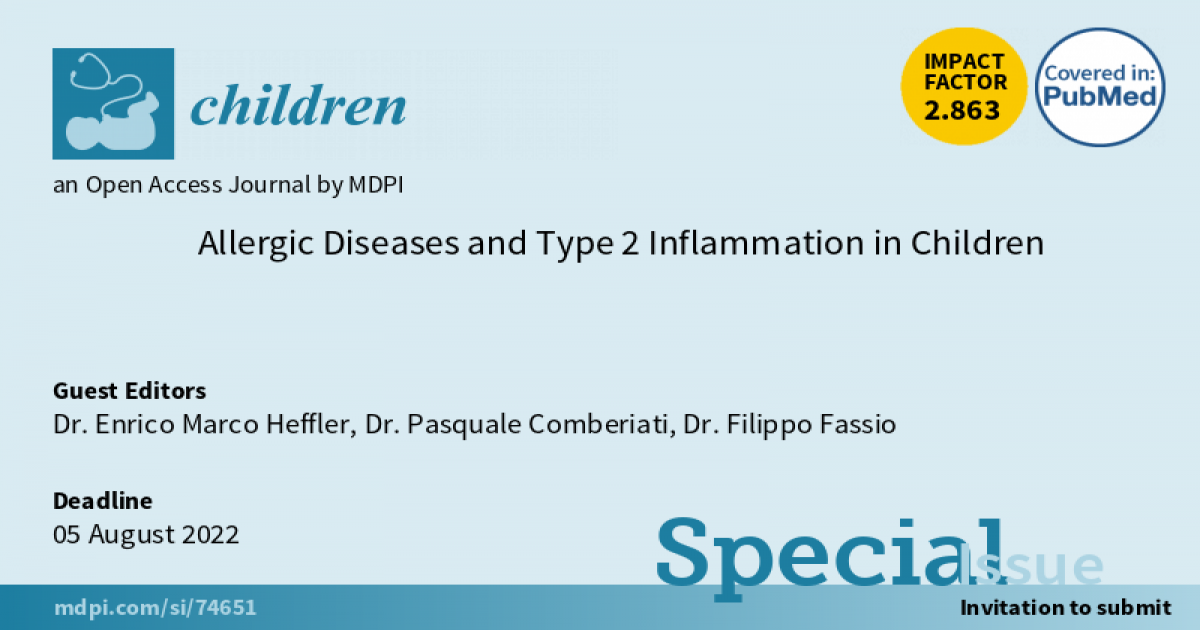Allergic Diseases and Type 2 Inflammation in Children
A special issue of Children (ISSN 2227-9067). This special issue belongs to the section "Pediatric Allergy and Immunology".
Deadline for manuscript submissions: closed (5 August 2022) | Viewed by 15257

Special Issue Editors
Interests: severe asthma; nasal polyps; airway inflammation; biomarkers; anaphylaxis
Special Issues, Collections and Topics in MDPI journals
2. Department of Clinical Immunology and Allergology, IM Sechenov First Moscow State Medical University, Russia.
Interests: allergy; asthma; atopy; children; food allergy; immunotherapy
Special Issues, Collections and Topics in MDPI journals
Special Issue Information
Dear Colleagues,
Allergic diseases have a high prevalence in the population, and this is truer for the pediatric population. They can occur from very early childhood, as occurs in cow’s milk protein allergy, or later. They can remain stable until adulthood, or evolve into other forms, as occurs in the so-called “atopic march”.
In recent years, the treatment of allergic diseases—and in particular of more complicated conditions, such as severe asthma or severe atopic dermatitis—has been revolutionized by new therapies, largely based on biologics, initially used for the treatment of adult patients and then progressively used successfully also in pediatrics.
These are characterized by “type 2 inflammation”, which consists in the activation of Th2 cells, which secrete cytokines such as IL-4, IL-5, and IL-13, which in turn stimulate the activation of eosinophils, mast cells, and basophils.
In all these conditions, the outcome is immune dysregulation and epithelial barrier dysfunction.
In this Special Issue of Children, we would like to offer the opportunity to share the latest advances in the field of allergic diseases in childhood, with a special focus on type 2 inflammation.
We welcome reviews and original research considering novel approaches, as well as identifying gaps in knowledge. We also encourage submissions that explore how quality of life is affected by these conditions, or how the COVID-19 pandemic has impacted the organization of allergy care and the treatment of allergic children.
We look forward to receiving your contributions.
Dr. Enrico Marco Heffler
Dr. Pasquale Comberiati
Dr. Filippo Fassio
Guest Editors
Manuscript Submission Information
Manuscripts should be submitted online at www.mdpi.com by registering and logging in to this website. Once you are registered, click here to go to the submission form. Manuscripts can be submitted until the deadline. All submissions that pass pre-check are peer-reviewed. Accepted papers will be published continuously in the journal (as soon as accepted) and will be listed together on the special issue website. Research articles, review articles as well as short communications are invited. For planned papers, a title and short abstract (about 100 words) can be sent to the Editorial Office for announcement on this website.
Submitted manuscripts should not have been published previously, nor be under consideration for publication elsewhere (except conference proceedings papers). All manuscripts are thoroughly refereed through a single-blind peer-review process. A guide for authors and other relevant information for submission of manuscripts is available on the Instructions for Authors page. Children is an international peer-reviewed open access monthly journal published by MDPI.
Please visit the Instructions for Authors page before submitting a manuscript. The Article Processing Charge (APC) for publication in this open access journal is 2400 CHF (Swiss Francs). Submitted papers should be well formatted and use good English. Authors may use MDPI's English editing service prior to publication or during author revisions.
Keywords
- Pediatric
- Children
- Allergy
- Asthma
- Component Resolved Diagnosis
- Food Allergy
- Drug Allergy
- Venom Allergy
- Allergic Rhinitis
- Type 2 Inflammation
- Immunotherapy







